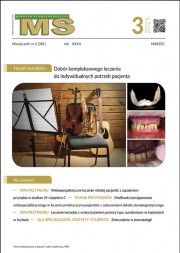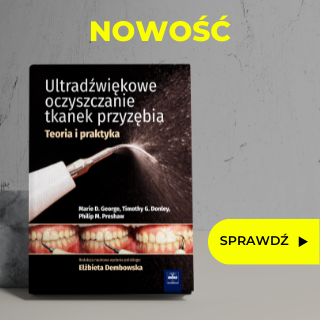Dostęp do tego artykułu jest płatny.
Zapraszamy do zakupu!
Po dokonaniu zakupu artykuł w postaci pliku PDF prześlemy bezpośrednio pod twój adres e-mail.
Bartłomiej Górski
PIŚMIENNICTWO
1. Huynh-Ba G. i wsp.: The effect of periodontal therapy on survival rate and incidence of complications of multirooted teeth with furcation involvement after an observation period of at least 5 years: a systematic review. J. Clin. Periodontol., 2008, 36, 2, 164-176.
2. Hamp S.E., Nyman S., Lindhe J.: Periodontal treatment of multirooted teeth. Results after 5 years. J. Clin. Periodontol., 1975, 2, 3, 126-135.
3. Tarnow D., Fletcher.: Classification of the vertical component of furcation involvement. J. Periodontol., 1984, 55, 5, 283-284.
4. Paolantonio M. i wsp.: Molar root furcation: morphometric and morphologic analysis. Int. J. Periodontics Restorative Dent., 1998, 18, 1, 489-501.
5. Hou G.L., Tsai C.C.: Types and dimensions of root trunk correlating with diagnosis of molar furcation involvement. J. Clin. Periodontol., 1997, 24, 2, 129-135.
6. Kerns D.G. i wsp.: Root trunk dimensions of 5 different tooth types. Int. J. Periodontics Restorative Dent., 1999, 19, 1, 83-91.
7. Chiu B.M. i wsp.: Periodontal implications of furcation entrance dimensions in Chineses first permanent molars. J. Periodontol., 1991, 62, 5, 308-311.
8. Helldén L.B. i wsp.: Prognosis of tunnel preparations in treatment of class III furcations. A follow-up study. J. Periodontol., 1989, 60, 11, 182-187.
9. Little L.A. i wsp.: Lack of furcal bone loss following the tunneling procedure. J. Clin. Periodontol., 1995, 22, 8, 637-641.
10. Rüdiger S.G.: Mandibular and maxillary furcation tunnel preparations – literature review and a case report. J. Clin. Periodontol., 2001, 28, 1, 1-8.
11. Dannewitz B., Krieger J.K., Eickholz P.: Loss of molars in periodontally treated patients: a retrospective analysis after five years or more after active periodontal treatment. J. Clin. Periodontol., 2006, 33, 1, 53-61.
12. Zimmer S., Jahn K.R., Barthel C.R.: Recommendations for the use of fluoride in caries prevention. Oral Health Prev. Dent., 2003, 1, 1, 45-51.
13. Niemann R.W. i wsp.: Dye ingress in molars: furcation to chamber floor. J. Endod., 1993, 19, 6, 293-296.
14. Bosshardt D.D., Sculean A.: Does periodontal tissue regeneration really works? Periodontol. 2000, 2009, 51, 1, 208-219.
15. Haghighati F., Saaveh G.: Essentials in periodontal regeneration. J. Dent., 2006, 4, 2, 78-88.
16. American Academy of Periodontology: Periodontal regeneration. J. Periodontol., 2005, 76, 9, 1601-1622.
17. Bashutski J.D., Wang H.L.: Periodontal and endodontic regeneration. J. Endod., 2009, 35, 3, 321-328.
18. Yukna R.A. i wsp.: Evaluation of durapatite ceramica as an alloplastic implant in periodontal osseous defects. II. Twelve-month reentry results. J. Periodontol., 1985, 56, 9, 540-547.
19. Pamela K., McClain P.K., Schallhorn R.G.: Focus on furcation defects-guided tissue regeneration in combination with bone grafting. Periodontol. 2000, 2000, 22, 1, 190-212.
20. Gottlow J. i wsp.: New attachment formation in human periodontium by GTR. Case reports. J. Clin. Periodontol., 1986, 13, 6, 604-616.
21. Yukna R.A., Yukna C.N.: Six-year clinical evaluation of HTR synthetic bone grafts in human grade II molar furcations. J. Periodontol. Res., 1997, 32, 8, 627-633.
22. Eickholz P., Hausmann E.: Evidence for healing of periodontal defects 5 years after conventional and regenerative therapy: digital subtraction and bone level measurements. J. Clin. Periodontol., 2002, 29, 10, 922-928.
23. Eickholz P. i wsp.: Long-term results of guided tissue regeneration therapy with non-resorbable and bioabsorbable barriers. III. Class II furcations after 10 years. J. Periodontol., 2006, 77, 1, 88-94.
24. Khanna D., Malhotra S., Naidu D.V.: Treatment of grade II furcation involvement using resorbable guided tissue regeneration membrane: a six-month study. J. Indian Soc. Periodontol., 2012, 16, 3, 404-410.
25. Houser B.E. i wsp.: Clinical evaluation of anorganic bovine bone xenograft with a bioabsorbable collagen barrier in the treatment of molar furcation defects. Int. J. Periodontics Restorative Dent., 2001, 21, 2, 161-169.
26. Lekovic V. i wsp.: Treatment of class II furcation defects using porous hydroxyapatite in conjunction with a polytetrafluoroethylene membrane. J. Periodontol., 1990, 61, 9, 575-578.
27. Anderegg C.R. i wsp.: Clinical evaluation of the use of decalcified freeze-dried bone allograft with guided tissue regeneration in the treatment of molar furcation invasions. J. Periodontol., 1991, 62, 4, 264-268.
28. Khashu H., Vandana K.L.: Clinical and radiographic evaluation of human periodontal osseous defect (mandibular grade II furcation) treated with PepGen P-15 and a bioresorbabale membrane (Atrisorb). J. Indian Soc. Periodontol., 2012, 16, 4, 569-576.
29. Andersson B. i wsp.: Treatment of furcation defects. Guided tissue regeneration versus coronally positioned flap in mandibular molars, a pilot study. J. Clin. Periodontol., 1994, 21, 3, 211-216.
30. Couri C.J. i wsp.: Medical grade calcium sulfate hemihydrate versus expanded polytetrafluoroethylene in the treatment of mandibular class II furcations. J. Periodontol., 2002, 73, 11, 1352-1359.
31. Cury P.R.: Long term results of guided tissue regeneration therapy in the treatment of class II furcation defects. J. Periodontol., 2003, 74, 1, 3-9.
32. Tsao Y.P. i wsp.: Effects of a mineralized human cancellous bone allograft in regeneration of mandibular class II furcation defects. J. Periodontol., 2006, 77, 3, 416-425.
33. Calongne K.B.: Clinical comparison of microporous biocompatible composite of PMMA, PHEMA and calcium hydroxide grafts and expanded polytetrafluoroethylene barrier membranes in human mandibular molar class II furcations. A case series. J. Periodontol., 2001, 72, 10, 1451-1459.
34. Metzler D.G. i wsp.: Clinical evaluation of guided tissue regeneration in the treatment of maxillary class II molar furcation invasions. J. Periodontol., 1991, 62, 6, 353-360.
35. Sanz M., Giovannoli J.L.: Focus on furcation defects: guided tissue regeneration. Periodontol. 2000, 2000, 22, 1, 169-189.
36. Palioto D.B.: Clinical and radiographic treatment evaluation class III furcation defects using GTR with and without inorganic bone matrix. J. Clin. Periodontol., 2003, 30, 1, 1-8.
37. Keila S. i wsp.: In vitro effects of enamel matrix proteins on rat bone marrow cells and gingival fibroblasts. J. Dent. Res., 2004, 83, 2, 134-138.
38. Galli C. i wsp.: Osteoprotegerin and receptor activator of nuclear factor-kappa B ligand modulation by enamel matrix derivative in human alveolar osteoblasts. J. Periodontol., 2006, 77, 7, 1223-1228.
39. Walter C. i wsp.: Moderate effect of enamel matrix derivative (Emdogain Gel) on Porphyromonas gingivalis growth in vitro. Arch. Oral Biol., 2006, 51, 3, 171-176.
40. Bosshardt D.D.: Biological mediators and periodontal regeneration: a review of enamel matrix proteins at the cellular and molecular levels. J. Clin. Periodontol., 2008, 35, Suppl. 8, 87-105.
41. Pietruska M.D.: A comparative study on teh use of Bio-Oss and enamel matrix derivative (Emdogain) in the treatment of periodontal bone defects. Eur. J. Oral Sci., 2001, 109, 3, 178-181.
42. Sculean A. i wsp.: Treatment of infrabony defects with an enamel matrix protein derivative or bioabsorbable membrane: an 8-year follow-up split-mouth study. J. Periodontol., 2006, 77, 11, 1879-1886.
43. Heden G., Wennstöm J.L.: Five-year follow-up of regenerative periodontal therapy with enamel matrix derivative at sites with angular bone defects. J. Periodontol., 2006, 77, 2, 295-301.
44. Trombelli L., Farina R.: Clinical outcomes with bioactive agents alone or in combination with grafting or guided tissue regeneration. J. Clin. Periodontol., 2008, 35, Suppl. 8, 117-135.
45. Chitsazi M.T. i wsp.: Efficacy of open flap debridement with and without enamel matrix derivatives in the treatment of mandibular degree II furcation involvement. Clin. Oral Investig., 2007, 11, 4, 385-389.
46. Jepsen S. i wsp.: A randomized clinical trial comparing enamel matrix derivative and membrane treatment of buccal Class II furcation involvement in mandibular molars. Part I: study design and results for primary outcomes. J. Periodontol., 2004, 75, 9, 1150-1160.
47. Meyle J. i wsp.: A randomized clinical trial comparing enamel matrix derivative and membrane treatment of buccal Class II furcation involvement in mandibular molars. Part II: secondary outcomes. J. Periodontol., 2004, 75, 9, 1188-1195.
48. Hoffmann T. i wsp.: A randomized clinical trial comparing enamel matrix derivative and membrane treatment of buccal Class II furcation involvement in mandibular molars. Part III: patient factors and treatment outcome. J. Clin. Periodontol., 2006, 33, 8, 575-583.
49. Jaiswal R., Deo V.: Evaluation of the effectiveness of enamel matrix derivative, bone grafts, and membranes in the treatment of mandibular Class II furcation defects. Int. J. Periodontics Restorative Dent., 2013, 33, e58-604. doi: 10.11607/prd.1428.
50. Donos N. i wsp.: Clinical evaluation of an enamel matrix derivative in the treatment of mandibular degree II furcation involvement: a 36-month case series. Int. J. Periodontics Restorative Dent., 2003, 23, 5, 507-512.
51. Casarin R.C. i wsp.: Influence of anatomic features on the effectiveness of enamel matrix derivative proteins in the treatment of proximal Class II furcation involvements. Quintessence Int., 2009, 40, 9, 753-761.
52. Casarin R.C. i wsp.: A double-blind randomized clinical evaluation of enamel matrix derivative proteins for the treatment of proximal class-II furcation involvements. J. Clin. Periodontol., 2008, 35, 5, 429-437.
53. Casarin R.C. i wsp.: Enamel matrix derivative proteins for the treatment of proximal class furcation involvements: a prospective 24-month randomized clinical trial. J. Clin. Periodontol., 2010, 37, 12, 1100-1109.
54. Donos N. i wsp.: Clinical evaluation of an enamel matrix derivative and a bioresorbable membrane in the treatment of degree III mandibular furcation involvement: a series of nine patients. Int. J. Periodontics Restorative Dent., 2004, 24, 4, 362-369.














